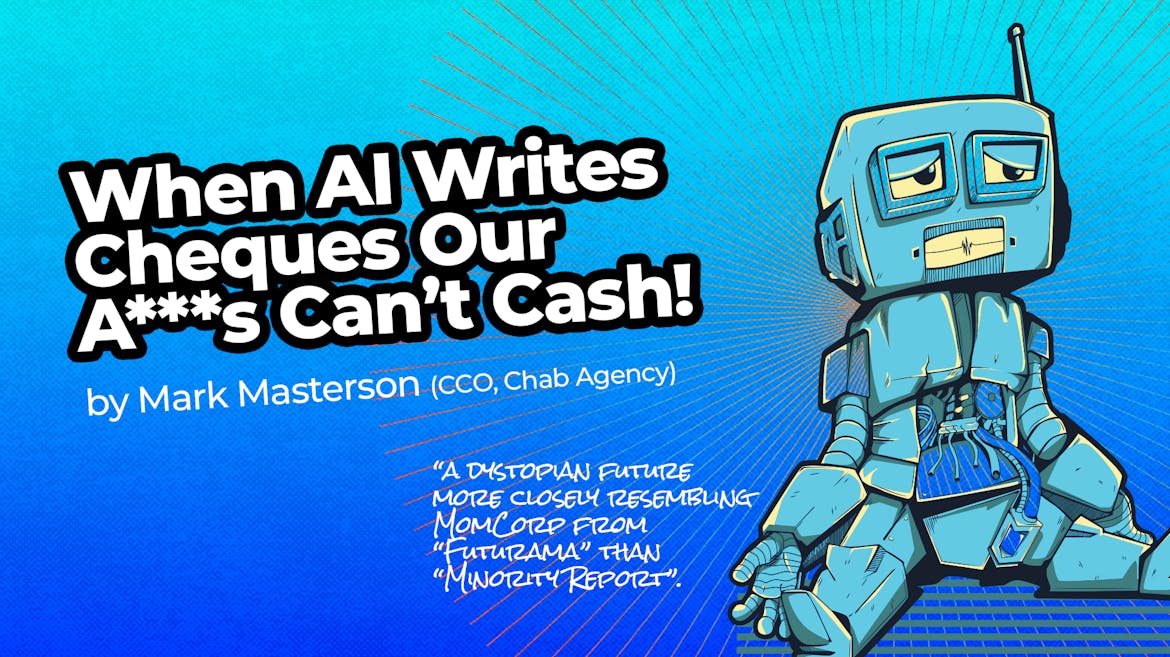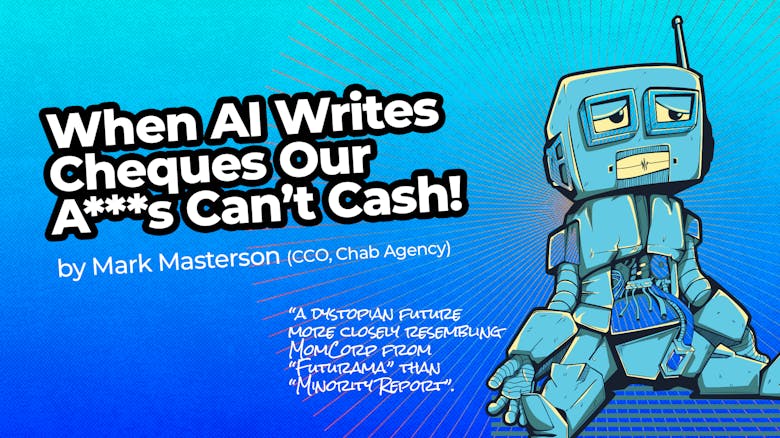
When AI Writes Cheques Our Asses Can’t Cash!
Mark Masterson"After Mark left a comment on a Creativepool article I wrote about AI and the democratisation of creativity, I quickly took the opportunity to connect with him to pick his brain, not least because of his 25+ years’ experience in Creative Director roles at the likes of McCann, IPG, DDB, and now Chab Agency.
I quizzed him on the impact AI would have on traditional agency structures and the way they bill clients, and Mark shared his predictions which included a premonition for a dystopian future more closely resembling MomCorp from “Futurama” than “Minority Report”. Read on…” (Nick Sadeghian)
When shit gets real, it comes with a bill.
As AI evolves, we will see laws and actions, such as U.S. President Joe Biden's October ‘23 executive order, which introduces guardrails for its development and use. And as we know, once things begin to happen, that's where real confusion meets utter disarray.
Ultimately, what this will look like—at least until it doesn’t—is a client invoice for creative that looks a lot more like a rental car agreement or a detailed airline ticket than a normal agency bill.
If this is the direction of us, it’s going to be a fucking nightmare that’s going to require AI to decipher and help bring new meaning to “the good ol’ days.”
Because with all content for a generative AI image, sentence, recording, or even font usage to be tracked, there will need to be code embedded into the creative software and/or watermarks on every piece of information that’s gone into what we’d like to call “new.”
In the short term, everybody is screwed because it's like we’ve all left our wallets of talent open and unattended on the subway, but once it occurs to the creators and software makers, service agreements are going to start including things like limited ownership of any art product produced by said creative suite. There will be battles over who owns what everywhere, and line after line of attribution and negotiated costs will appear on the agency invoice. It’s a little like how Adobe has decided to treat font foundries now, but on a hyper-scale. Some lucky designers, photographers, and writers may end up with pay-checks akin to those paid by Spotify, but most of us will be fucked.
The media companies have been consolidating for a long while now, but what’s become big in that world won’t be “too big to fail.” What it’s going to look like is a huge zit being popped, leaving only a tiny scar of what used to be the most profitable part of the industry. Companies like Nestlé, which are going deep into AI with only a small nod to creative, are already looking at the numbers more than the pixels, and eventually, the AI will be negotiating directly with the clients for the clients for the placements. Fun, right?
Of course, the top creatives and agencies will still be there, but as small and fast “'roided-up” entities that bill heavy and make amazing creative for an ever-shrinking audience. As I’m prone to saying, it’ll be like Cannes every day. This is the last stand for the real artists and makers. It’ll be back to the days when agencies are seen as magical, but then again, eventually, they won’t be anymore.
For the consumers—you remember those, right?—for those people, the rise of the machines makes for a twist of Marx as corporate machines marketing directly to your refrigerator bring some real “opium of the people” to the humans as advertising is replaced with entertainment, sort of like Prime Video does for Amazon customers. A lot of those sponsored TikTok videos and old-timey :30 spots are going to find themselves as pure entertainment with no commercial breaks as the brands' only real value comes from rewarding their consumers with either free stuff or real kickbacks like the credit cards do. Yes, your future is going to look a lot more like one run by MomCorp from "Futurama" than "Minority Report.”
The initial question was about the future of agency billing, which will heavily depend on the agency's focus. I've mentioned previously that the real future of connectivity lies with those specialists that the 4A’s either spun off or never claimed throughout their existence. Companies like Jack Morton, Momentum, and Freeman, which have existed in the shadows of giants like McCann Worldgroup and TBWA, will emerge with their experiential offerings and events, providing consumers with meaningful engagements. And while their creatives may succumb to the fates of automation, areas like sponsorships, partnerships, and production will reveal where the true power of revenue lies. This newfound influence will percolate down to the creative departments, who, although still touted as stars, embody more than former B-list celebrities with a knack for design and imagery: they possess the know-how to physically connect and build something tangible.
As a note, for what used to be the outlier: the freelancer, this may become the prevalent role of the creative as the required expertise goes away. Freelance has always been nice if you like to control bits of your own destiny, but an absolute pain in the ass when it comes to marketing yourself, billing, and actually getting paid—especially when dealing with smaller clients who are prone to stiffing “the help.”
Another challenge for the freelance, and agency alike, could come from a move to performance- and use-based pay. With all of these watermarks, tracking methods, and abilities to score interactions, clients, whether client-side or agency-side, may see an opportunity to screw the creative yet one more time by tying compensation to not only the work, but their own poor direction and decision.
Is the Future Use Based Compensation?
In a way, agencies have been relying on something like this for years, as “pitch fees” disappeared long ago, and the number of agencies expected to pitch for even the smallest of contracts increased from the standard three to up to seven or more, with little hope of even breaking even. They were asked to invest in something with as low as a 15% chance of getting paid, then hammered on about costs.
So, what I’m envisioning (because of greed, right?) is that clients will take it to the next level and, after paying a small fee for production/creation, will tie actual compensation to the ever-increasing and trackable numbers.
With this new tracking, it’s not going to be as simple as 'impressions' or purchases. With AI and a watermarking system, we’ll be able to drill down to the bits of image, audio, or whatever was used by the computer machine to make whatever it is that’s used.
It may sound like a headline from The Onion, “Woman Saves Failing Brand by Posting About Its Use as a Laxative,” but we've already reached a point where the success of a product or brand can be traced back to a single blog post. One person can be the catalyst, where the micro scales to the macro; it's only a matter of time before we can not only track but also harness and compensate for such influences. So, why not track a specific shade of particular blue eye used by AI to create a face, which is then identified as the most successful eye for marketing when utilized by generative AI?
AND, if that blue eye belongs to you, the photographer who took the picture, and in some part to the social media company where it was posted, why shouldn’t you or all of you get paid?
Because, once we start paying by performance, our freelance art director joins a speculative market that either pays or doesn’t, and even the agency can begin basing salaries on success instead of offering bonuses based on it. When the art or idea or whatever we can track, finds success, the creative gets paid along with the ever-lengthening long tail that they’ve been forced to use in making whatever it is they make — of course, along the way, while the creators get a fraction of a fraction of a cent, the tracking companies and platforms will be taking their cut.
Yes, shit's gotten real, and the bill is coming due, but not without many, many taxes and surcharges.
The agency world is already enigmatic to outsiders because it demands daily auditions, and each assignment serves as a performance review. Gaps in employment are particularly significant; your portfolio is your CV, and your face is, quite literally, your CV. But as our industry and the means of measuring talent evolve—or devolve, depending on your perspective—life in a 4As shop becomes even more confounding. It's a stark contrast to the experience in a smaller agency. The competition is fierce, and the rules of the game are constantly changing. And in a land where any decision to exit may mean a highly suspect and difficult return, sustaining life without a net becomes just about as appealing as sustaining yourself as a Grab driver and less reliable. If you are one of the lucky ones who is allowed to actually make things, you’ll need to run it through an app, surely developed with the help of Adobe, to track possible success based on your use of just about everything. Welcome to a land that's the same, yet different.
I think what many of us, who have been invited to and then forced to accept the exponentially growing changes brought on by technology, are asking at this point is: “When will the future stop?” This is a pretty good question to be asking as the speeds of change have careers in China ending at 35 and the value of talent becoming less than that of those who magically kept our once-upon-a-time-ago offices clean.
As we begin, not just seeing salaries go lower and positions continue to disappear, but fighting beyond just 'billable hours' and for impactful numbers, how will we truly gauge whether we’re good or successful? While much success today relies on the “suits” who sell and successful uses of the budget, the whole idea of some compensation for anybody but the stockholders gets pretty complicated.
For those of us who’ve come to the more senior levels of the agency world, we briefly had some solace in the belief that there’d still be Creative Directors, but who the fuck knows at this point? This prognostication, just a year old, already feels outdated. In the world of AI, changes happen exponentially and unpredictably. A year can feel like a decade. Where some of us thought maybe we could hold on for 10 or even 20 years, that boiling expansion in the post-COVID period, when combined with AI and downturn, may be a burst, an open sore, and a scab of another sort that’s not about healing, but crossing a line and replacing our humanity.
In this shit storm of change, where AI and market forces redefine our roles daily, we’ve got to ask ourselves: What bits of our humanity will remain in our creativity? As we navigate through this changing landscape, our challenge is to maintain the real, our touch and imaginations, in an industry increasingly governed by algorithms and bottom lines. The true measure of our success might well lie in our ability to blend the technological with the human, ensuring that in our pursuit of efficiency, we don't lose the essence of what makes us unique as creative beings. BUT this will be a very human choice and directive.
Should we all be asked to go back and watch Star Trek to see how society could make sure we all can continue to eat and survive?
I’m sure that many of us will be long gone before society figures out that people who can’t work also can’t buy things. Thank god.
Subscribe to Ingenuity’s content hub
Receive the latest interviews, insights and trends straight to your mailbox.
